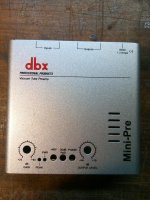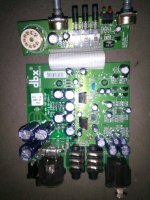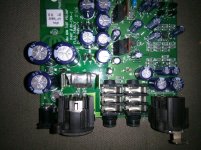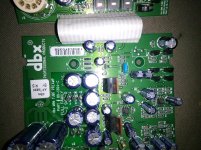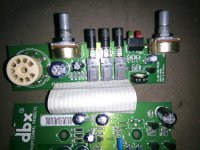Hi guys.
I have 3 of these dbx "professional products" mini pre amps on my desk (small boxes, 5 x 5 x 1.5 inch in size). All 3 present the same problem: background (pink) noise is too high, even at low output volume. When they were bought, they worked all right, without noise. The owner said that the noise developed gradually.
These pres are powered by a 9VAC 1300mA wallwart. The electronics are all on the same PCB with smd parts, except for diodes and caps and some ICs like transistors and voltage regulators. Could it be that some components of the power supply has gone bad? How can I check this?
Does anyone know where to find a schematic for these dbx mini pres?
Thanks in advance for your help.
I have 3 of these dbx "professional products" mini pre amps on my desk (small boxes, 5 x 5 x 1.5 inch in size). All 3 present the same problem: background (pink) noise is too high, even at low output volume. When they were bought, they worked all right, without noise. The owner said that the noise developed gradually.
These pres are powered by a 9VAC 1300mA wallwart. The electronics are all on the same PCB with smd parts, except for diodes and caps and some ICs like transistors and voltage regulators. Could it be that some components of the power supply has gone bad? How can I check this?
Does anyone know where to find a schematic for these dbx mini pres?
Thanks in advance for your help.
Apply the principle of the Gordian Knot - first place is that wallwart. Does it power all three or have you three wall warts?How can I check this?
Ok, and you said someone brought them in. I presume then that the pink noise is not present on the mains? (Noise on the mains is getting worse every year)
It is essential to rule that out first. If you preamps have phantom power, check that this is clean too.
The components most likely to have failed gradually are electrolytic caps but this normally manifests as hum rather than pink noise. Old carbon comps resistors get noisy but SMD devices should all be metal film and as quiet as physics allows.
Without a schematic, one is left with tracing the signal back through the circuit and trying to find where the noise is injected. A way to do this is to feed in a tone (if you don't have a tone generator, use your phone and an app like f-generator) at an appropriate level and trace the increasing/decreasing volume across the PCB.
Interesting!
It is essential to rule that out first. If you preamps have phantom power, check that this is clean too.
The components most likely to have failed gradually are electrolytic caps but this normally manifests as hum rather than pink noise. Old carbon comps resistors get noisy but SMD devices should all be metal film and as quiet as physics allows.
Without a schematic, one is left with tracing the signal back through the circuit and trying to find where the noise is injected. A way to do this is to feed in a tone (if you don't have a tone generator, use your phone and an app like f-generator) at an appropriate level and trace the increasing/decreasing volume across the PCB.
Interesting!
Last edited:
Hi.
What "mains" are you exactly referring to: 110 VAC of the local power grid or the mains inside the preamps? Local power grid sucks, BTW. hI feed the preamps into a Mackie 1202-VLZ4 console the has the same smd architecture, is possibly even older than the dbx's, and does not generate any noise at all. I do have an old tone generator.
And yes, not having the schematics is a pain in the butt....
What I do not have is an oscilloscope to trace the signal...
What "mains" are you exactly referring to: 110 VAC of the local power grid or the mains inside the preamps? Local power grid sucks, BTW. hI feed the preamps into a Mackie 1202-VLZ4 console the has the same smd architecture, is possibly even older than the dbx's, and does not generate any noise at all. I do have an old tone generator.
And yes, not having the schematics is a pain in the butt....
What I do not have is an oscilloscope to trace the signal...
What I do not have is an oscilloscope to trace the signal...
Use another preamp & monitor speaker or headphones.
Mains - wall power (110VAC or 230VAC). If that's got lots of noise on it, that can find its way into the audio circuit. It depends a lot on the design of the power supplies in the equipment - and luck in circuit design.
It used to be that the level of noise would drop off at night as computers, TVs and machinery were turned off. These days there's so many always-on gear making noise (e.g. Wifi, modems, set-top-boxes) that I don't find it so clear cut.
I got myself an oscilloscope. Well, kind of, I modified a very old Macintosh monitor so I can see frequency oscillation. Although, I have no idea how to interpret these... I also have a headphone amp...
Could you tell me what I should focus on, while poking around in the circuit board?
Could you tell me what I should focus on, while poking around in the circuit board?
What we're trying to find is the signal path, from input, via various gain stages, to the output. The signal level will increase along that path (with some loss at tone/volume knobs)Could you tell me what I should focus on, while poking around in the circuit board?
Take a photocopy of your board so you can record what you're doing.
In theory, somewhere along that path the noise is getting injected. That is, up until that point there's little or no noise in your signal and after that lots of noise in the signal.
Beware of grounding issues - I spent three hours yesterday trying to debug a board which had its ground floating on 6V of AC noise 😱 Every time I'd stick a scope probe on it it would misbehave (74HC74 clocking on the falling edge of the clock 😕) due to ground currents 😡 😡
Free quoted from a Janis Yoplin song "Mercedes Benz":
"Oh Lord, won't you buy me
schematics for this amp.
All my friends have working amps,
I have none on hand..."
Well, yes. A schematic would be really nice.......
"Oh Lord, won't you buy me
schematics for this amp.
All my friends have working amps,
I have none on hand..."
Well, yes. A schematic would be really nice.......
Just to do something in the right direction you can take a couple detailed readable closeups, one from component side, one from copper side, so at least we have an idea of what are you dealing with.
At least whether it´s a pure Tube circuit, a Hybrid, if so what transistors or Op Amps does it have, etc.
At least whether it´s a pure Tube circuit, a Hybrid, if so what transistors or Op Amps does it have, etc.
Have had lots of problems with noisy ecc83 tubes took a few attempts to find quiet ones for a high gain hot tubes distortion box !!!!!.
they're called ECC803. Or CV4004. Or 7025. Or 12AX7A. Or....
Of course these days, whether the part number and performance has any correlation is a bone of contention 😱
Of course these days, whether the part number and performance has any correlation is a bone of contention 😱
Here are some pics attached.
Attachments
The Philips NOS ECC83 that I tried was in really good shape when I tested it. And as to johnsurnamerobinson, I know these high gain tube distortion boxes, they all make a hell of noise, and that is basically their purpose.
Back to my problem...
I replaced the 2 caps (47uF/50V) on all 3 preamps, the caps that are just below the ribbon that connects both pcbs. They all were leaking electrolyte so they had to be replaced anyway. There are 4 caps (2x 100uF/63V + 2x 47uF/50V), just behind the XLR input connector. When I touch their metal top, there is a huge noise increase, but this noise is also present with new caps installed, so I think this is supposed to be. When I remove the tubes from the preamps, the noise disappears. I don't no if this is expected or if this could be a clue...
Still searching for the fxxxing schematics...
Back to my problem...
I replaced the 2 caps (47uF/50V) on all 3 preamps, the caps that are just below the ribbon that connects both pcbs. They all were leaking electrolyte so they had to be replaced anyway. There are 4 caps (2x 100uF/63V + 2x 47uF/50V), just behind the XLR input connector. When I touch their metal top, there is a huge noise increase, but this noise is also present with new caps installed, so I think this is supposed to be. When I remove the tubes from the preamps, the noise disappears. I don't no if this is expected or if this could be a clue...
Still searching for the fxxxing schematics...
Just a thought:> If the vac tube revival is to contiue.Should we not all be campiening for TOP QUALITY TUBES.
Plus electrolytic caps are a real problem I am about to start on a Epiphone valve junior not powered up for years oh boy!!!
Plus electrolytic caps are a real problem I am about to start on a Epiphone valve junior not powered up for years oh boy!!!
In the entire world, there are only two or three factories that are still manufacturing tubes today. They are mostly staffed by elderly people who learned their skills decades ago, and are now approaching retirement. The factories are owned and operated by other elderly people, also approaching retirement, who still have a fondness for tube technology.If the vac tube revival is to contiue.Should we not all be campiening for TOP QUALITY TUBES.
Meantime, consumer Hi-Fi audio is dead. There is a small tube audio fad market still alive, but like all fads, it probably won't last very long.
The electric guitar itself is ageing out of most contemporary music. Digitally simulated guitar amps are getting better, and are putting heavy price pressure on the few remaining tube guitar amps. I can't see younger musicians forking out $1000 for a tube guitar amp when they can buy a $300 solid-state Boss Katana that sounds almost as good (these are typical Canadian prices.)
From what I see, today's entire tube ecosystem has one foot in the grave, and the other on a banana-peel. 😱
Just to be clear: it's not that I want tubes to disappear. Not at all. I'm just staring at what seems to be the inevitable future.
-Gnobuddy
Actually I have a similar feeling about the state of the hi-fi industry in the UK.Specialist shops are dissapearing.Most young people seem perfectly happy with lossy MP3 played through rotty in ear phones.
I don't know for sure whether tube factories have come down to only two or three or not.
And the fact that youngsters settled to hearing mp3 songs on their iPods and feeling comfortable about it is just a result of technological progress and no one can stop this.
But that doesn't solve my actual problem. I'm still looking for a schematic or some other helping clue.
And the fact that youngsters settled to hearing mp3 songs on their iPods and feeling comfortable about it is just a result of technological progress and no one can stop this.
But that doesn't solve my actual problem. I'm still looking for a schematic or some other helping clue.
- Status
- Not open for further replies.
- Home
- Live Sound
- Instruments and Amps
- dbx mini tube pres with noise
